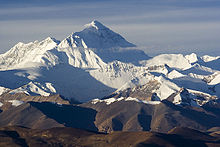Mount Everest
Earth's highest mountain above sea level, located in the Mahalangur Himal sub-range of the Himalayas
Mount Everest or Qomolangma or Sagarmatha or Chomolungma pronounced as (Jongmalunga) is the highest mountain on Earth, as measured by the height of its summit above sea level. The mountain, which is part of the Himalaya range in High Asia, is located on the border between Nepal and China.


Quotes
edit- If the reason for climbing Mt. Everest is that it's hard to do, why does everyone go up the easy side?
- George Carlin, Napalm & Silly Putty (2001), p. 45
- We have for some years known that this mountain is higher than any other hitherto measured in India, and most probably it is the highest in the whole world.
I was taught by my respected chief and predecessor, Colonel Geo. Everest, to assign to every geographical object its true local or native appellation. I have always scrupulously adhered to this rule, as I have in fact to all other principles laid down by that eminent graduist.
But here is a mountain, most probably the highest in the world, without any local name that we can discover, or whose native appellation, if it have any, will not very likely be ascertained before we are allowed to penetrate into Nepal and to approach close to this stupendous snowy mass.
In the mean time the privilege, as well as the duty, devolves on me to assign to this lofty pinnacle of our globe, a name whereby it may be known among geographers and become a household word among civilized nations.
In virtue of this privilege, in testimony of my affectionate respect for a revered chief, in conformity with what I believe to be the wish of all the Members of the scientific department, over which I have the honour to preside, and to perpetuate the memory of that illustrious master of accurate geographical research, I have determined to name this noble peak of the Himalayas "Mount Everest."- Andrew Waugh, who named the peak, previously designated Peak XV, as "Everest", in a report (1 March 1856), publicly read on 11 May 1857, and published in "Papers relating to the Himalaya and Mount Everest" in Proceedings of the Royal Geographical Society of London, Vol. I (1857), p. 346
- You will perceive the gist of the question is not whether the mountain should be called Mount Everest or by its true native name (which is a principle not disputed by any one), but whether it can be called Deodanga without risk of error, in the absence of satisfactory proof that this is really its native name.
- Andrew Waugh, in a report on Mounts Everest and Deodanga (11 January 1858), published in Proceedings of the Royal Geographical Society of London, Vol. II, No. 1 (January 1858), p. 105
- A symmetrical, beautiful snow cone summit.
- Sir Edmund Hillary who with Tenzing Norgay became the first people known to reach the summit of Mount Everest. As quoted in "On This Day : 29 May" at BBC